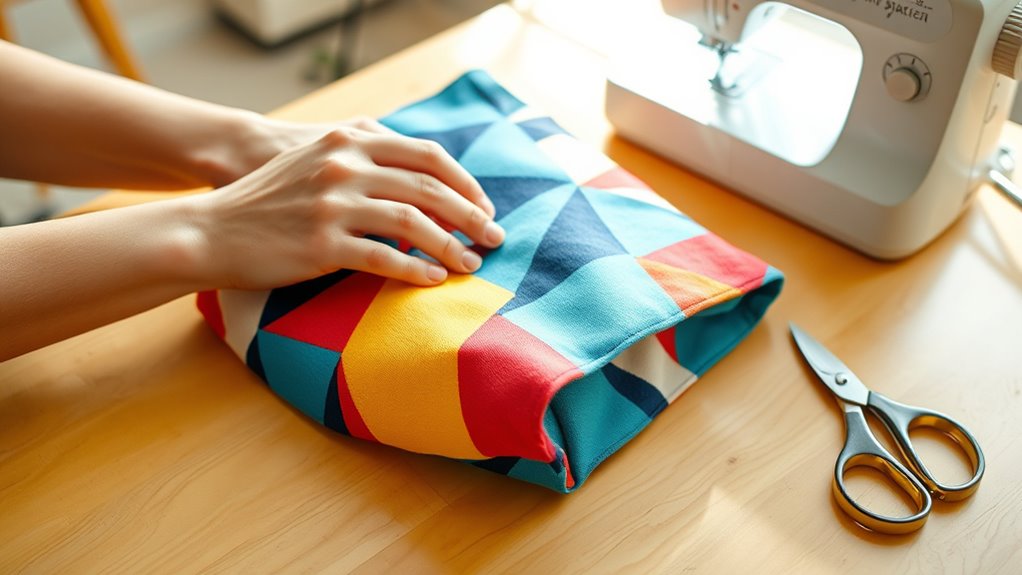To sew an easy tote bag at home, start by gathering durable fabric, matching thread, and essential tools like scissors and a sewing machine. Measure and cut your fabric into the right-sized pieces, then pin them together before sewing along the edges. Attach handles securely, finish raw edges with zigzag or binding, and add personal touches like fabric paint or patches. Keep practicing; you’ll discover more tips to customize your perfect tote as you go.
Key Takeaways
- Gather durable fabric, matching thread, and essential sewing tools, then cut fabric pieces according to your tote size.
- Measure and mark fabric accurately before cutting to ensure clean, even edges and proper fit.
- Pin fabric pieces securely and sew the main body and handles with straight stitches, reinforcing stress points.
- Finish raw edges with zigzag stitching, serging, or bias tape to prevent fraying and give a polished look.
- Customize your tote with decorative elements like patches, embroidery, or fabric paint for a personalized touch.
Gathering Your Materials and Tools
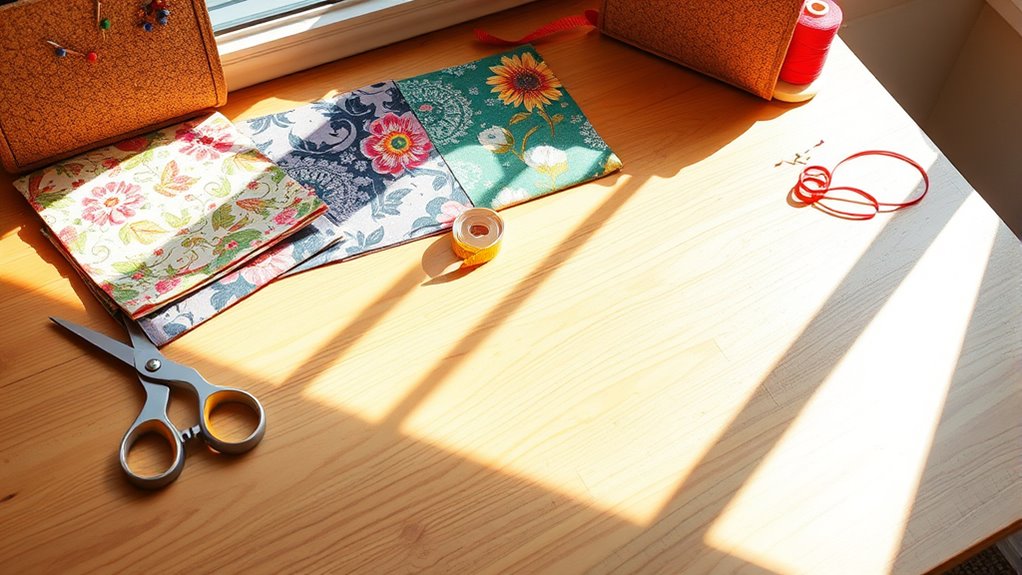
Before you begin sewing your tote bag, gather all the necessary materials and tools. You’ll need fabric—preferably sturdy canvas or cotton—measured according to your desired bag size. Pick out matching or contrasting thread that complements your fabric. Don’t forget a sewing machine, pins or clips to hold pieces together, and fabric scissors for clean cuts. A seam ripper can be handy for mistakes, while a measuring tape helps ensure accuracy. You might also want chalk or a fabric marker to mark sewing lines. Keep these items in a designated workspace to stay organized. Having everything ready before you start saves time and prevents interruptions, making the sewing process smoother and more enjoyable. Understanding suitable fabrics and their properties can help you choose the best materials for your tote bag project. Being aware of the different types of sewing tools can also improve your efficiency and the quality of your finished bag. Additionally, familiarizing yourself with fabric care instructions can ensure your tote remains durable over time. When selecting your fabric, consider fiber content to ensure it aligns with your project’s durability and care needs. A good grasp of fabric properties can further assist you in making informed choices for your sewing project.
Cutting the Fabric Pieces

Start by selecting the fabric type that best suits your tote, considering durability and appearance. Next, carefully measure and mark your fabric to make sure accurate cuts. To enhance the rustic look, consider vintage decor elements that complement your fabric choices. Additionally, choosing unique and wicked planters or eco-friendly materials can add a creative touch to your project. Incorporating space-saving solutions can help you organize your workspace efficiently. Remember, embracing failure during the process can lead to innovative design ideas and improvements. Also, understanding leadership skills such as problem-solving and strategic thinking can inspire you to approach your project with confidence. Finally, cut precisely along your markings to get clean, even pieces for your bag.
Choose Fabric Type
Choosing the right fabric type is essential for a sturdy and attractive tote bag. You want a material that’s durable enough to carry your essentials without tearing or stretching. Cotton canvas is a popular choice because it’s strong, easy to sew, and holds its shape well. Denim and sturdy upholstery fabrics also work great for a more rugged look. If you prefer something lighter, consider quilting cotton or linen, but keep in mind they may be less durable. Avoid flimsy fabrics like silk or chiffon, which won’t hold up to daily use. Think about how you plan to use your tote and select a fabric that matches your needs for strength and style. Additionally, self watering plant pots are made from durable materials that can withstand outdoor conditions, which can inspire your choice of sturdy fabric. Selecting a fabric with weather-resistant qualities can further enhance your tote’s durability and longevity. For added durability, choosing fabrics with woven structures can help ensure your tote bag withstands regular wear and tear. Using fabrics with moisture-wicking properties can also be beneficial if you plan to carry items that might be damp or wet. Once you’ve chosen the fabric, you’re ready to move on to cutting the pieces.
Measure and Mark
How do you guarantee your tote bags come out perfect? It all starts with accurate measuring and marking. Use a clear ruler or measuring tape to determine the correct dimensions for your bag pieces. Mark your fabric with fabric chalk or a washable marker, ensuring straight, precise lines. Double-check your measurements before cutting to avoid mistakes later. Keep your markings visible but gentle enough not to damage the fabric. If you’re making multiple bags, consider creating a template to maintain consistency. Proper measuring and marking set the foundation for neat seams and a professional look. Taking your time to ensure each piece is exactly the right size—your effort will pay off with a well-made tote bag that looks great and holds up well. Additionally, understanding the importance of precise measurements and how they can impact the overall accuracy of sewing can help prevent errors that might lead to uneven seams or ill-fitting parts. Ensuring your measurements are accurate can also improve the contrast ratio of your finished tote, making the colors pop and creating a more polished appearance. Paying attention to paint spray techniques can also inspire careful precision in your cutting and marking process, contributing to a cleaner final product. Moreover, using quality tools can significantly enhance the precision of your measurements and markings, resulting in a more professional-looking tote bag.
Cut Precisely
Once you’ve marked your fabric accurately, the next step is to cut out your pieces carefully. Use sharp fabric scissors for clean, precise cuts, and make certain you cut along your marked lines. Keep your scissors steady and avoid rushing to prevent uneven edges. If you’re cutting multiple layers, make sure they’re stacked evenly to maintain consistency. Pay attention to the grainline markings to keep your tote sturdy and well-shaped. Take your time, and double-check each piece against your pattern to avoid mistakes. Properly cut pieces will make sewing easier and result in a professional-looking tote. Remember, accurate cutting is the foundation of a successful project, so don’t rush this step. Precision here ensures your finished tote looks neat and fits together perfectly. Additionally, understanding automation in industry can inspire you to streamline your sewing process and increase efficiency.
Pinning and Preparing the Pieces for Sewing
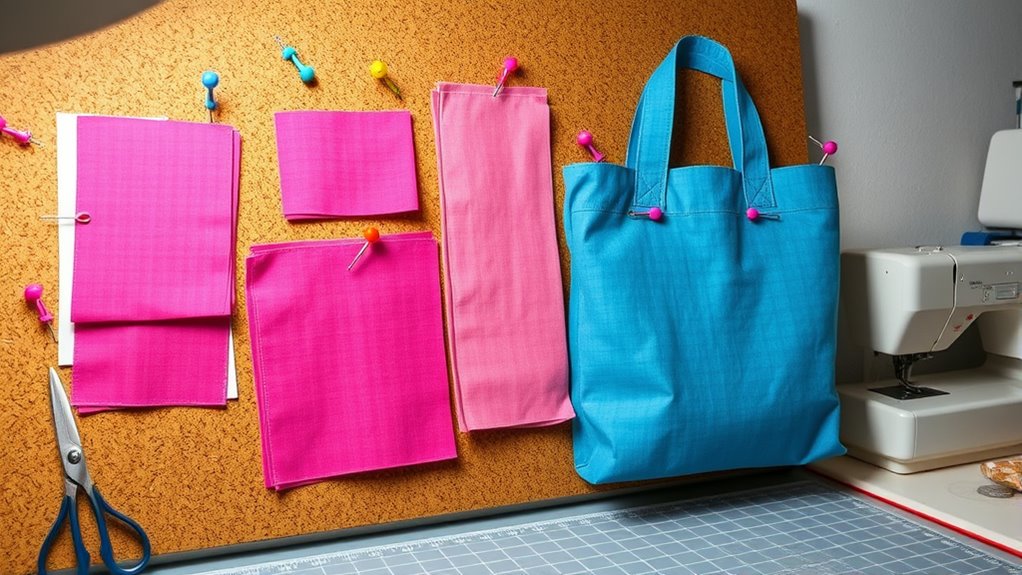
Before you start sewing, it’s important to carefully pin and prepare your fabric pieces to guarantee they stay aligned and don’t shift. Proper pinning keeps everything in place, making sewing smoother. Lay out your pieces on a flat surface, matching edges precisely. Use straight pins to secure the layers, placing them perpendicular to the edges for easy removal. To help visualize, here’s a simple overview:
| Fabric Piece | Pins Placement | Purpose |
|---|---|---|
| Front Panel | Along the edges | Keeps layers aligned |
| Back Panel | Perpendicular | Prevents shifting |
| Handles | Near edges | Holds in position |
| Bottom | Spread evenly | Ensures stability |
Take your time with this step to ensure accuracy before sewing. Incorporating essential survival gear can also be helpful in case of emergencies during outdoor crafting or traveling.
Sewing the Main Body of the Tote Bag
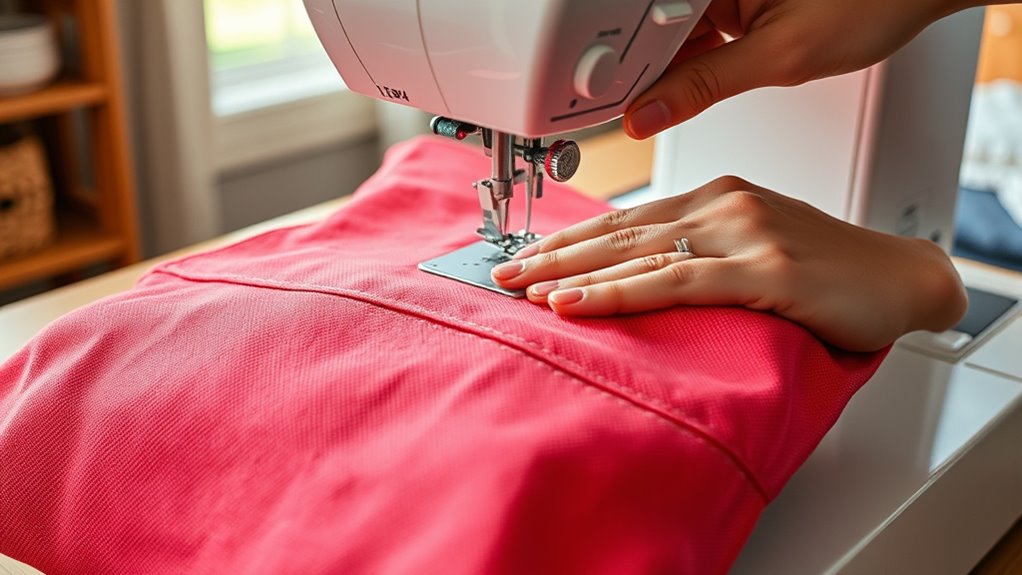
With your fabric pieces securely pinned, it’s time to sew the main body of the tote bag. Start by sewing along the pinned edges with a straight stitch, about 1/4 inch from the edge. Be sure to guarantee a small seam allowance to prevent fraying. Sew each side of the bag separately, then press the seams open with an iron to create a crisp finish. If your fabric has a pattern or nap, sew with the right sides together to ensure the design lines up properly. Keep your stitches even and consistent for a professional look. Once you finish sewing both sides, trim any excess threads and press the seams again. This step forms the basic structure of your tote bag, ready for the next stage.
Attaching the Handles
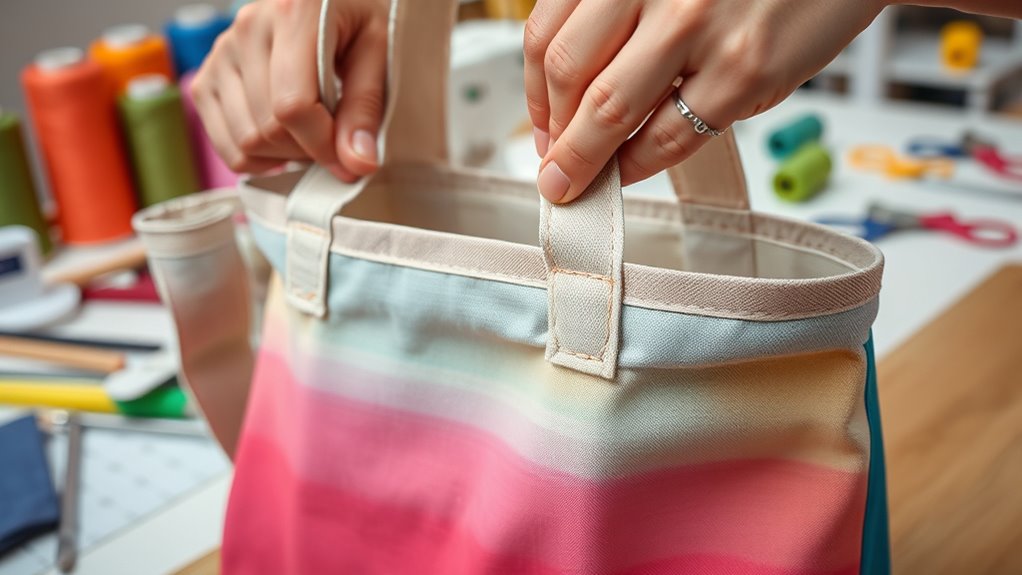
Attaching the handles is a crucial step that gives your tote bag both functionality and style. First, position the handles evenly on each side of the bag’s opening, making sure they’re aligned and facing the right way. Pin or clip them securely in place to prevent shifting. Next, sew across the handles with a strong, straight stitch, reinforcing the attachment by sewing back and forth a few times. Be sure to sew close to the edge for a clean look and added durability. If your handles are long, you can fold the ends inside before sewing for a polished finish. Check that both handles are securely attached and aligned. Once done, you’re ready to move on to the final touches.
Finishing Touches and Edges

To give your tote bag a professional finish, you’ll want to focus on seam finishing techniques that prevent fraying. Topstitching not only adds durability but also enhances the bag’s appearance, especially along stress points. Edge binding methods can create a clean, polished look while reinforcing the edges for everyday use.
Seam Finishing Techniques
Seam finishing is essential to give your tote bag a professional look and prevent fraying over time. Properly finished seams guarantee durability and a polished appearance. You can use various techniques, such as zigzag stitching, pinking shears, or serging, to secure raw edges. Zigzag stitching is easy and works well for most fabrics, while pinking shears cut a zigzag pattern that minimizes fraying. If you have a serger, it’s the fastest way to neatly finish edges and trim excess fabric simultaneously. For lightweight fabrics, bias tape or binding can also be applied to cover raw edges completely. Choose the method that best suits your fabric type and sewing skills. Finishing your seams properly guarantees your tote bag stays intact and looks professional.
Topstitching for Durability
Topstitching adds both strength and a professional finish to your tote bag’s edges and seams. By sewing a row of stitches close to the edge, you reinforce the seams, preventing fraying and ensuring the bag holds up over time. Use a matching or contrasting thread to enhance the design, depending on your style preference. Keep your stitches even and consistent, which not only improves durability but also gives your tote a polished look. For best results, set your sewing machine to a slightly longer stitch length, around 3.0 to 3.5 mm. Topstitching is especially important around handles, straps, and the top edge, where stress is greatest. This simple step makes your tote more durable and adds a professional touch to your handmade bag.
Edge Binding Methods
Finishing edges neatly not only enhances the appearance of your tote bag but also protects it from fraying and wear over time. One effective method is binding the raw edges with bias tape or fabric strips, which creates a clean, professional look. To do this, fold the binding over the edge and sew it in place, ensuring the raw edge is fully enclosed. Another popular technique is topstitching along the edges, which secures the seam and adds decorative detail. For a more polished finish, you can also use a serger to overlock the edges, preventing fraying while giving a clean edge. Whichever method you choose, consistent and precise finishing will make your tote bag more durable and visually appealing.
Tips for Customizing Your Tote Bag

Adding personal touches is a great way to make your tote bag uniquely yours. You can customize it with fabric paint, iron-on patches, or embroidery to reflect your style. Think about adding a bold pattern or a meaningful quote to stand out. Using different materials like cork or metallic fabric can give your tote a fresh look. To inspire creativity, here’s a quick comparison:
| Technique | Effect |
|---|---|
| Fabric Paint | Bright, artistic designs |
| Iron-on Patches | Fun, textured accents |
| Embroidery | Elegant, detailed patterns |
| Appliqué | Layered fabric visuals |
Choose one or combine several for a truly personalized tote. Experimenting with colors and textures turns a simple bag into a custom statement piece.
Frequently Asked Questions
Can I Recycle Old Fabrics for Tote Bags?
Absolutely, you can recycle old fabrics for tote bags. Just choose sturdy materials like denim, canvas, or thick cotton to guarantee durability. Wash and iron the fabric first to remove wrinkles and any residues. Cut your pieces to the desired size, then sew the edges securely. Recycling old fabrics not only gives your tote a unique look but also helps reduce waste and makes your project more eco-friendly.
What Are the Best Fabrics for Durable Tote Bags?
When choosing fabrics for durable tote bags, you want sturdy materials that can handle heavy loads. Canvas, denim, and heavy-duty cotton are excellent options because they’re strong and long-lasting. You might also consider recycled materials like sturdy upholstery fabric or thick canvas from old sails or backpacks. These fabrics resist wear and tear, ensuring your tote bag stays intact and looks great over time.
How Do I Repair a Torn Tote Bag?
When your tote bag gets torn, don’t worry. First, assess the damage and gather matching thread and a needle or sewing machine. Turn the bag inside out, then sew the tear closed with small, tight stitches for durability. For larger rips, reinforce the area with fabric patches on the inside. Once finished, turn your bag right side out and enjoy your repaired, sturdy tote again.
Can I Make a Tote Bag Waterproof?
You might think making a tote bag waterproof is complicated, but it’s easier than you imagine. You can add a waterproof coating or use waterproof fabric like nylon or treated canvas. Applying a spray-on waterproofing product is quick and effective, keeping your bag dry during rain. With a few simple steps, you’ll have a durable, water-resistant tote ready for anything, perfect for daily use or outdoor adventures.
What Sewing Machine Settings Are Ideal for Tote Bags?
For sewing tote bags, you should set your machine to a straight stitch, usually at a medium length of about 2.5mm. Use a heavy-duty needle, like a size 90/14, to handle thicker fabric. Adjust the tension if needed, ensuring even stitches without puckering. Test on scrap fabric first. Keep your sewing speed steady to achieve strong, durable seams that hold up well with everyday use.
Conclusion
Now that you’ve sewn your tote bag, you’ll notice how a simple project unexpectedly turns into a personal creation. As you carry it around, the fabric feels just right, reminding you of how easy it was to make something so useful. Every stitch, every handle, becomes a part of your story. So, next time you need a bag, remember this moment—because sometimes, the best things happen when you least expect them.
